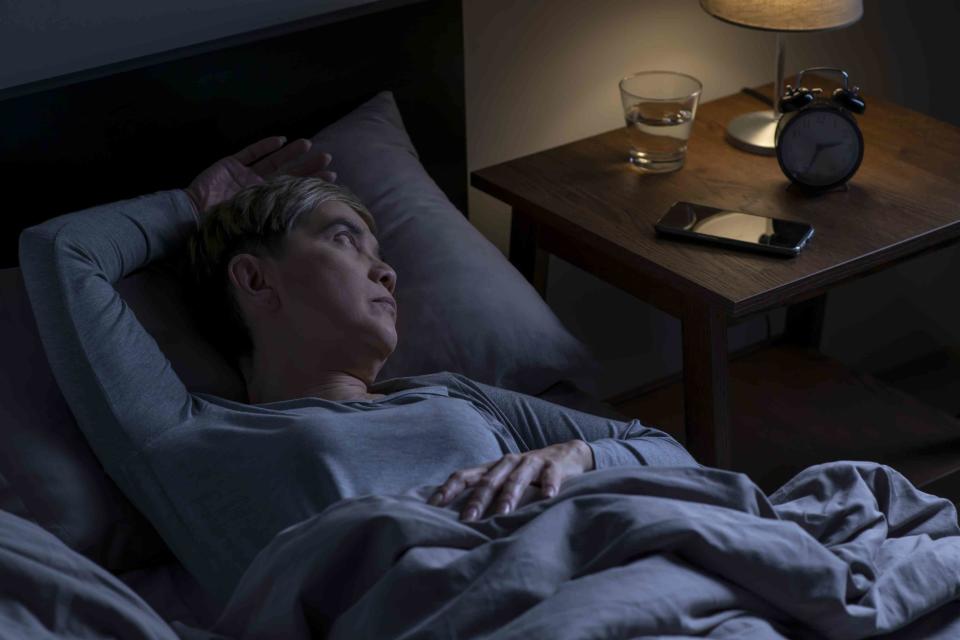Understanding Nightmare Disorder
PTSD commonly causes repeated, disturbing dreams

Filmstax / Getty Images
Medically reviewed by Michael MacIntyre, MD
Nightmare disorder affects between 3% and 8% of the general population, causing distress for those affected. It often occurs alongside other mental illnesses. One study of 498 people with moderate to severe mental illness found that 70% experienced recurrent nightmares.
Having nightmares does not always mean that you have a mental illness. However, you may have a nightmare disorder if you have repeated nightmares that adversely affect your daily functioning.
This article will define nightmare disorder, outline its causes, and provide treatment and coping options.

Filmstax / Getty Images
Repeated Bad Dreams: Definition of Nightmare Disorder
Nightmare disorder is a mental illness defined by the Diagnostic and Statistical Manual of Mental Disorders, Fifth Edition (DSM-5). A person with nightmare disorder has recurring nightmares that affect their daily functioning and cause distress.
According to the DSM-5, nightmares are defined as disturbing or distressing dreams that occur during rapid eye movement (REM) sleep and usually involve:
A threat to one's safety, security, or survival
A physical response to the dream, like sweating, shaking, or a rapid heart rate
Intense emotional reactions, like fear, anger, or sadness
Waking during the dream
Other mental or physical health conditions do not explain the nightmares
Frequency of Nightmares
The severity of nightmare disorder ranges from mild to severe and is determined by nightmare frequency. Here is how the severity of nightmares is determined:
Mild: Less than one nightmare per week
Moderate: One or more episodes a week
Severe: Daily nightmare
What Causes Nightmare Disorder?
Although there aren't any specific known causes of nightmare disorder, research does indicate several risks, especially those that directly affect REM sleep cycles. These include:
Certain medical conditions, such as migraines, bronchitis, and asthma
Medications, including beta-blockers and some selective serotonin reuptake inhibitors (SSRIs)
Alcohol withdrawal
Nightmares vs. Night Terrors
Nightmares are different from night terrors. With nightmares, you fully waken from the dream and immediately orient to your surroundings. Night terrors, however, come with difficulties fully wakening, being comforted, and remembering the dream.
Diagnosis: Should You See a Provider for Nightmare Disorder?
A mental health provider can bring comfort and coping mechanisms and track treatment progress. They can also determine whether other mental or medical disorders contribute to nightmares, including substance use disorder, schizophrenia, or PTSD.
Some people with nightmare disorders develop other mental health illnesses, such as depression, anxiety (primarily related to falling asleep), and insomnia. A mental health provider can develop a treatment plan to target co-occurring mental health conditions.
Prevalence of Nightmare Disorder
It is typical for people, especially children, to experience occasional nightmares. Research indicates that 20% of children have frequent nightmares, and 85% of adults have at least one nightmare yearly. Approximately 4% of adults experience symptoms that meet the diagnostic criteria for nightmare disorder.
Treating Nightmare Disorder
There are effective treatment methods to reduce the frequency and intensity of nightmares, including psychotherapy and medication, or a combination of the two.
Psychotherapy Treatment Options
Psychotherapy interventions include:
Imagery rehearsal therapy: A modified version of cognitive-behavioral therapy in which a person rehearses a less-frightening ending to a nightmare until the fear is nearly gone
Eye movement desensitization and reprocessing (EMDR): A treatment method frequently used for those experiencing trauma symptoms that involves processing a distressing thought, feeling, or memory while moving the eyes in a specific pattern
Exposure, relaxation, and re-scripting therapy: A cognitive-behavioral treatment where a person talks or writes about their nightmares, practices relaxation techniques, and comes up with a revised, less-frightening version
Sleep dynamic therapy: An intervention for people with sleep disorders that combines various medical and nonmedical evidence-based approaches to help improve sleep
Psychopharmacology Options
Depending on the severity of your condition and the success of nondrug (non-pharmacological) treatment options, a healthcare provider might prescribe you medication to help treat nightmare disorders. These include:
Mogadon (nitrazepam) treats anxiety and insomnia.
Minipress (prazosin) blocks the chemical that triggers the fight-or-flight response.
Halcion (triazolam) calms your nervous system.
How to Sleep Better With Nightmare Disorder
While nightmare disorders can be distressing, there are strategies to work toward improving your sleep. Here are some things to try:
Develop good sleep hygiene: Go to bed and wake up at the same time every night, including on weekends. Turn off screens at least two hours before bed. Create a calm environment with low lights and a comfortable temperature.
Practice relaxation techniques: Introduce calming activities to your bedtime routine, such as reading, listening to quiet music, and lightly stretching. Try deep breathing exercises or meditation to bring awareness to your thoughts and relaxation to your body before going to sleep.
Keep track of your nightmares: By keeping a nightmare log, you can identify patterns that lead to nightmares, determine the frequency, and distinguish between actual nightmares and distress surrounding the nightmare experience. This can lead to better control over sleep and emotions.
Waking Up From a Disturbing Dream: What to Immediately Do
If you wake up from a disturbing dream, here are a few ways to reorient and calm yourself:
Use positive self-talk: Say out loud to yourself, "I am OK. I'm in my room, and I am safe."
Slow your heart rate: Have a few exercises ready to help you calm down. You could try taking five deep breaths or picturing a soothing scene or image.
Use grounding techniques: Try looking around the room and naming everything you see that's a specific color or shape, or put your feet on the floor and focus on being in the present moment by noticing the feeling of the ground beneath you.
Summary
A nightmare disorder can be disturbing and cause significant fear and distress. It's normal to develop anxiety about going to sleep and experiencing disruptions to your daily life caused by missed sleep. People of all ages, genders, and experiences can have a nightmare disorder. If you experience nightmares regularly, there are treatment options that can help. Seek a mental health professional to determine the right treatment plan and learn helpful coping strategies.

